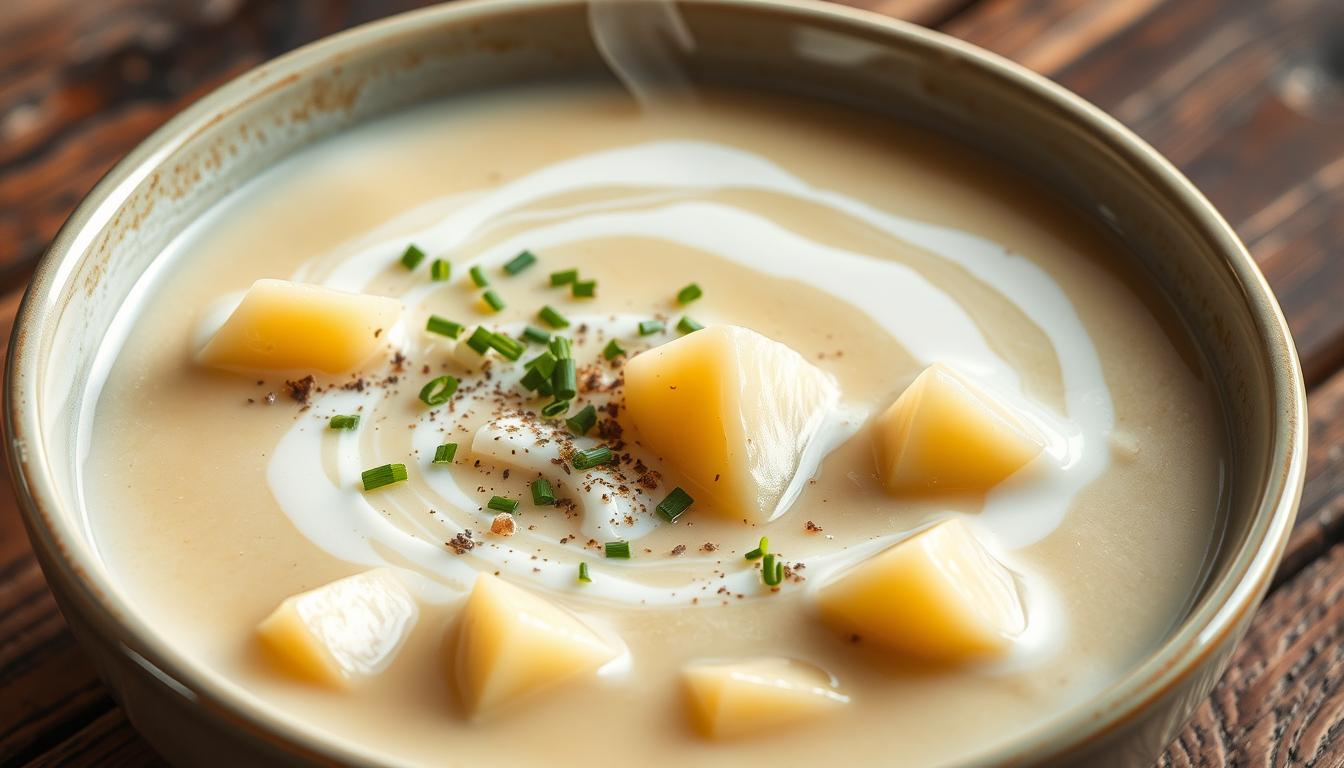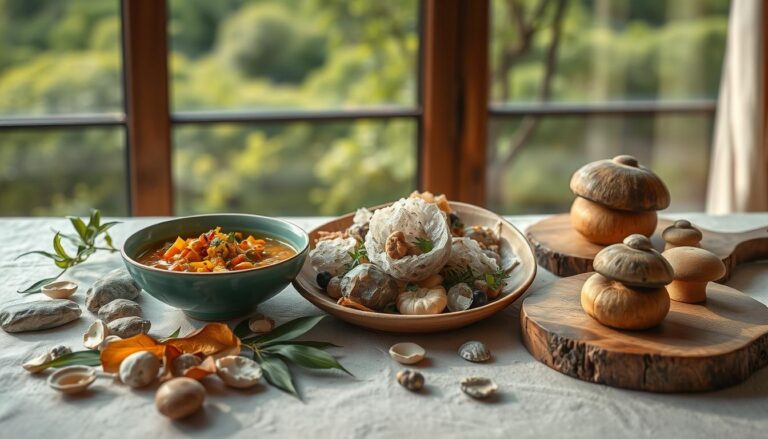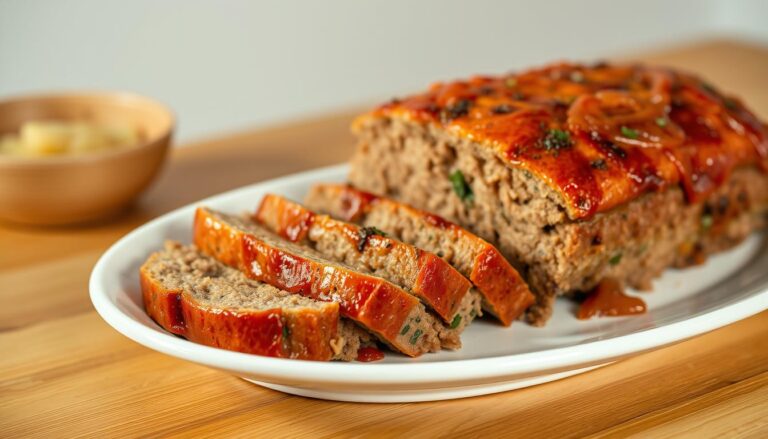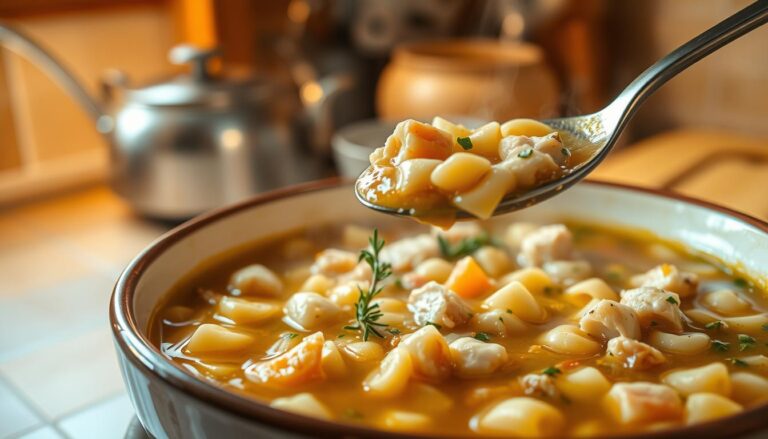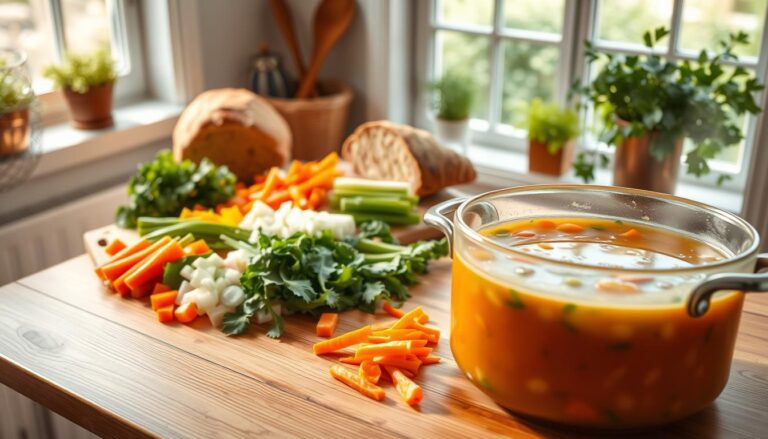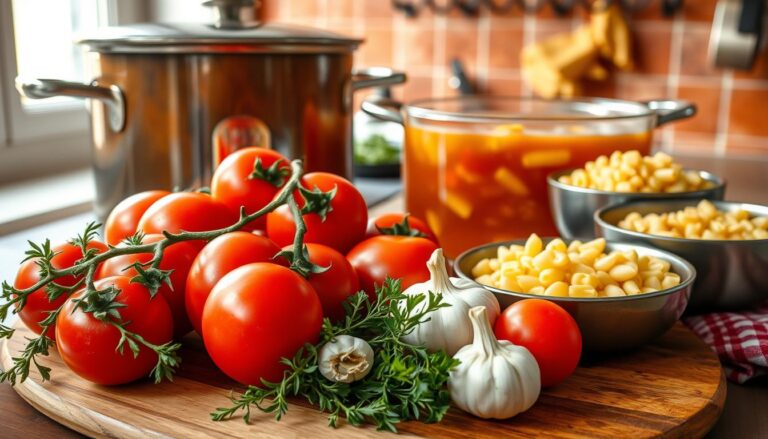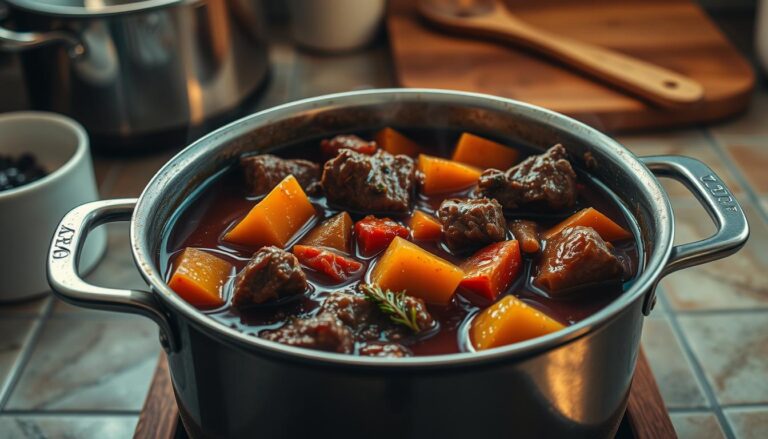Do you crave something that feels like a warm hug? A dish that makes your heart happy and your belly full? You’re not alone. On a cold night, nothing beats a bowl of homemade potato soup to warm your soul.
This beloved dish is more than a meal; it’s a hug in a bowl. Its rich texture and deep flavors make it a treat to keep coming back for. Our potato soup recipe is packed with secrets to make it extra creamy and comforting.
Exploring this comforting potato soup recipe reveals the joy of cooking in just one pot. It’s filled with bacon and potatoes, making it a favorite in any kitchen.
Table of Contents
The Comfort and Appeal of Homemade Potato Soup
There’s something special about a warm, creamy bowl of homemade potato soup. It’s a dish that everyone loves and is easy to make with basic ingredients.
Homemade potato soup has been a favorite for years. But why is it so loved?
Why Potato Soup Remains a Beloved Classic
Potato soup is loved for its simplicity and warmth. It’s an easy potato soup recipe that uses common ingredients. The mix of tender potatoes, aromatic veggies, and creamy texture is very comforting.
Health Benefits of Potato-Based Soups
Potato soup is not just comforting; it’s also good for you. Potatoes are full of vitamins and minerals. When you add other veggies, you get a meal full of nutrients. A creamy potato soup can be healthier by using low-fat cream or substitutes.
Some key health benefits of potato-based soups include:
- Rich in vitamins and minerals
- High in fiber, which aids digestion
- Can be made with low-fat ingredients for a healthier version
Essential Ingredients for the Ultimate Potato Soup Recipe
To make the best potato soup, choose your ingredients carefully. The quality of your soup depends on the freshness and type of ingredients.
Choosing the Right Potatoes
The type of potatoes you pick can change the soup’s texture and taste. Yukon Gold potatoes are great because they’re buttery and soft. They’re perfect for a creamy soup because they’re both starchy and waxy.
Base Ingredients You’ll Need
You’ll need a few basic ingredients for a rich and tasty soup. These include onions, garlic, broth, and milk for creaminess. Using top-notch broth and aromatics like onions and garlic will make your soup more flavorful.
Optional Add-ins for Extra Flavor
For more flavor, add some optional ingredients. Try cooked bacon or ham for a smoky taste. Diced herbs like chives or parsley add freshness. A sprinkle of grated cheese adds richness.
| Ingredient | Purpose | Options |
|---|---|---|
| Potatoes | Main ingredient | Yukon Gold, Russet, or Red |
| Broth | Base flavor | Chicken, vegetable, or beef broth |
| Dairy/Non-dairy milk | Creaminess | Milk, cream, almond milk, or soy milk |
| Aromatics | Flavor enhancers | Onions, garlic, leeks |
Secret #1: The Right Potato Variety Makes All the Difference
The secret to a creamy and comforting potato soup starts with selecting the right potatoes. The type of potato you choose can significantly impact the texture and flavor of your soup.
Starchy vs. Waxy Potatoes
Potatoes are generally categorized into two main types based on their starch content: starchy and waxy. Starchy potatoes, like Russet potatoes, are high in starch and low in moisture. They are light and fluffy on the inside while crispy on the outside when cooked. They are ideal for soups because they break down easily and contribute to a creamy texture. On the other hand, waxy potatoes, such as Red Bliss or New Potatoes, have a higher moisture content. They retain their shape even after cooking, making them better suited for salads or boiling.
Best Potato Varieties for Soup
For a healthy potato soup, you want to choose potato varieties that are not only delicious but also nutritious. Russet potatoes are a popular choice for potato soup due to their starchy nature, which helps to thicken the soup. Yukon Gold potatoes are another excellent option, offering a buttery flavor and a smooth texture. They are also relatively high in fiber and antioxidants, making your soup not just tasty but also nutritious.
Mixing Potato Types for Optimal Texture
Using a single type of potato can result in a great soup, but mixing different varieties can enhance both the texture and flavor. Combining starchy potatoes like Russet with waxy potatoes like Red Bliss can create a balanced soup that’s both creamy and chunky. Here’s a simple guide to mixing potato types:
| Potato Type | Characteristics | Contribution to Soup |
|---|---|---|
| Russet | Starchy, high yield | Creamy texture, thickens soup |
| Yukon Gold | Buttery flavor, smooth texture | Rich flavor, velvety texture |
| Red Bliss | Waxy, retains shape | Adds chunkiness, flavor contrast |
By choosing the right potato variety or mix, you can create a simple potato soup recipe that’s both comforting and delicious. Experimenting with different types will help you find the perfect balance for your taste preferences.
Secret #2: Proper Potato Preparation Techniques
The key to a great potato soup recipe is in how you prepare the potatoes. The way you cut and cook them can greatly affect the soup’s texture and taste. This is crucial for a delicious homemade potato soup.
To Peel or Not to Peel
One of the first choices you’ll make is whether to peel your potatoes. Leaving the skins on adds fiber and nutrients. But, it can also change the soup’s texture. If you decide to keep the skins, make sure to wash the potatoes well.
Cutting Techniques for Even Cooking
Cutting your potatoes into even pieces is key for even cooking. It’s best to cut them into pieces no bigger than ¾″. This ensures your soup has a uniform texture.
Pre-cooking Methods to Enhance Flavor
Pre-cooking your potatoes can make their flavors pop. Try roasting or sautéing them lightly before adding them to your soup. This step adds a rich, complex taste to your homemade potato soup.
By learning these potato preparation techniques, you’ll make a potato soup recipe that will impress everyone. It’s sure to be a hit with your family and friends.
Secret #3: Building a Flavorful Base
Creating a flavorful base is key to making an amazing potato soup. This step makes a great soup stand out. By focusing on a rich base, you’ll make a creamy potato soup every time.
The Importance of Aromatics
Aromatics are essential for a flavorful dish, like potato soup. Onions, garlic, and sometimes celery are the classic trio. Sauté them in butter or olive oil until they’re soft and smell great.
The third source suggests cooking vegetables with garlic and rosemary in butter. This not only enhances the taste but also makes your kitchen smell welcoming.
Creating a Rich Stock
The stock is a crucial part of your soup’s base. You can use vegetable or chicken stock, whichever you like. For a richer flavor, making your own stock is better than store-bought.
A rich stock makes your potato soup velvety and flavorful. It turns a bland soup into a grand one.
Layering Flavors for Depth
Layering flavors means adding ingredients at different cooking stages. Start with aromatics, then add potatoes, stock, and finally, cream or herbs. This way, your creamy potato soup will have a rich, satisfying flavor.
| Flavor Component | Ingredients | Contribution |
|---|---|---|
| Aromatics | Onions, Garlic, Celery | Depth and warmth |
| Stock | Vegetable or Chicken Stock | Richness and body |
| Layering | Potatoes, Herbs, Cream | Complexity and texture |
By focusing on these elements, you’ll make a creamy potato soup that’s both delicious and memorable. The secret is to take your time and let the flavors blend. This way, you’ll get a truly satisfying easy potato soup recipe.
Secret #4: Achieving the Perfect Creamy Texture
To make a truly exceptional potato soup, mastering the creamy texture is key. We’ll explore this in our fourth secret. The secret to a velvety potato chowder is blending, cream alternatives, and thickening methods.
Blending Techniques
Blending is crucial for the perfect creamy texture in your potato soup. Puree about half of the soup. This breaks down potatoes and releases starches, making it smooth and creamy.
Use an immersion blender in the pot for ease, or blend in batches for a deeper blend. Be careful with hot liquids. Blend in short pulses to avoid splashing.
Cream Alternatives for Dietary Restrictions
Not everyone can or wants to use traditional cream in their potato soup. Luckily, there are cream alternatives for a similar richness without dairy. Coconut cream adds a subtle flavor to potato chowder. Cashew cream, made by blending soaked cashews with water, is another great option for a creamy texture without dairy.
Thickening Methods Without Adding Flour
If you’re avoiding flour, there are other ways to thicken your potato soup. Mashing some potatoes in the pot releases starches and thickens it naturally. You can also use a roux made from butter and a gluten-free starch like cornstarch or tapioca flour.
Another method is to reduce the soup by simmering it uncovered. This concentrates flavors and thickens the soup. Try these methods to get the perfect creamy texture in your best potato soup recipe.
Secret #5: Balancing Flavors and Seasonings
The secret to a rich potato soup is balancing its flavors and seasonings. This balance is key for a healthy potato soup that’s both nourishing and tasty. To make a simple potato soup recipe shine, mastering seasoning is essential.
Essential Herbs and Spices
Herbs and spices are crucial for enhancing your potato soup’s flavor. Herbs like parsley, thyme, and bay leaves add depth without overwhelming the potatoes. A pinch of black pepper or a sprinkle of paprika can also make a big difference.
When to Add Salt and Pepper
Timing is everything when adding salt and pepper. Adding salt too soon can make the soup too salty. It’s best to add salt towards the end of cooking. Pepper can be added at different stages to build up the flavor.
Flavor Enhancers That Won’t Overpower
To add flavor without overpowering, consider using a bay leaf. Adding a bay leaf can add an extra layer of taste. You can also try garlic or onion powder, making sure they enhance the potato flavor without dominating it.
By carefully balancing flavors and seasonings, you can make a potato soup that’s delicious and healthy and simple to make. Try different herbs and spices to find the perfect mix for your taste.
Secret #6: Perfecting Your Toppings Game
Elevate your potato soup by mastering toppings. The right toppings add texture, flavor, and look. They turn a simple soup into a full meal. Whether you prefer classic or adventurous toppings, the key is balance and harmony.
Classic Potato Soup Garnishes
Classic toppings never go out of style. Shredded Cheddar cheese, crumbled bacon, and chopped green onions are favorites. They add flavor and make your soup look great. For an easy potato soup recipe, keep these staples ready.
Creative Topping Combinations
For those who like to try new things, there are many topping combinations. Add sour cream, chives, or crispy prosciutto for a unique twist. Customizing your potato soup recipe lets you choose your favorite flavors.
How to Layer Toppings for Maximum Impact
Layering toppings can make your soup amazing. Start with soup, then add toppings for a mix of flavors and textures. Try layering cheese, bacon, and green onions for a tasty and pretty soup.
Perfecting your toppings can turn a simple potato soup recipe into a memorable meal. Try different toppings and be creative. The best thing about making an easy potato soup recipe is making it your own.
Secret #7: Mastering the Timing and Serving
To make your potato soup stand out, timing and serving are key. The way you cook and serve your creamy potato soup affects its taste and texture.
Getting the cooking time right is crucial for the perfect texture. Cooking times vary based on the potato type and desired texture. For a chunky soup, cook it shorter. For a smooth soup, cook it longer.
Ideal Cooking Duration for Different Textures
Cooking time depends on the potatoes and the soup’s consistency. A simmering time of 15-20 minutes is usually best after adding potatoes. This ensures the potatoes are cooked and flavors blend well.
| Texture | Cooking Time | Description |
|---|---|---|
| Chunky | 15 minutes | Potatoes are slightly firm, retaining some texture. |
| Smooth | 20-25 minutes | Potatoes are fully cooked and blended for a creamy consistency. |
| Thick and Creamy | 25-30 minutes | Soup is simmered longer to reduce liquid and enhance creaminess. |
Resting Period: Why It Matters
Letting your potato soup rest before serving boosts its flavor. This resting time allows flavors to meld, creating a richer taste.
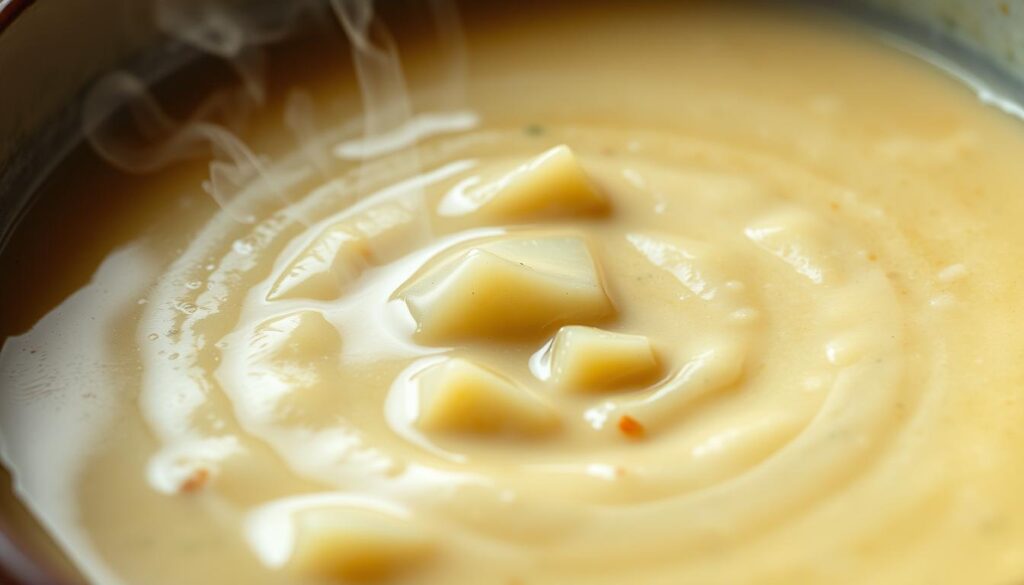
Temperature Considerations for Serving
Serving your best potato soup recipe at the right temperature is crucial. It should be hot, between 165°F and 170°F, for safety and flavor.
Mastering timing and serving turns your potato soup into a memorable dish.
Complete Potato Soup Recipe: Putting It All Together
Now, let’s make a perfect potato soup. We’ll use a simple yet tasty recipe. This guide will show you how to make a homemade potato soup that you’ll love.
Ingredients List
To make this simple potato soup recipe, you’ll need:
- 3-4 large potatoes, peeled and diced
- 2 tablespoons butter
- 1 medium onion, chopped
- 3 cloves garlic, minced
- 1 cup all-purpose flour
- 2 cups chicken or vegetable broth
- 1 cup milk or cream
- Salt and pepper, to taste
- Optional: chives, bacon bits, or grated cheese for garnish
Preparation Instructions
Before cooking, prep your ingredients. Peel and dice the potatoes, chop the onion, and mince the garlic. This will make cooking easier.
Cooking Process
Step-by-Step Cooking Instructions
- In a large pot, melt the butter over medium heat. Add the chopped onion and cook until softened, about 5 minutes.
- Add the minced garlic and cook for another minute, stirring constantly to prevent burning.
- Add the diced potatoes, broth, salt, and pepper. Bring to a boil, then reduce the heat and simmer until the potatoes are tender, about 15-20 minutes.
- Use an immersion blender to puree the soup until smooth. Alternatively, you can transfer the soup to a blender and blend in batches, then return it to the pot.
- Stir in the milk or cream to achieve the desired creaminess. Adjust the seasoning as needed.
- Serve hot, garnished with your choice of chives, bacon bits, or grated cheese.
Here’s a summary of the cooking process and nutritional information in a table format:
| Cooking Step | Time | Nutritional Impact |
|---|---|---|
| Cooking Potatoes | 15-20 minutes | Rich in potassium and fiber |
| Adding Cream/Milk | 2-3 minutes | Adds calories and calcium |
| Seasoning | 1 minute | Enhances flavor without adding calories |
By following this simple potato soup recipe, you’ll create a delicious and comforting homemade potato soup. It’s perfect for any occasion.
Delicious Variations of the Classic Potato Soup Recipe
There are countless ways to make potato soup. You can add your own twist to the classic recipe. This makes it perfect for any taste or dietary need.
Loaded Baked Potato Soup
Turn your potato soup into a loaded baked potato by adding toppings. Try crispy bacon, shredded cheddar cheese, sour cream, and chives. It’s great for those who love baked potatoes but want a soup.
Cheesy Potato Soup
For cheese fans, cheesy potato soup is a dream. Mix in cheddar, parmesan, or other cheeses for a creamy soup. A roux can thicken it without losing flavor.
Healthy Potato Soup Alternatives
Want a healthier option? Use less cream or try a non-dairy substitute. Adding spinach, kale, or carrots boosts the nutrition.
Vegan and Gluten-Free Options
For vegan soup, use plant-based butter and vegetable broth. Make sure your potatoes are gluten-free. You can also play with spices for more flavor.
Here’s a comparison of different potato soup variations:
| Variation | Key Ingredients | Dietary Suitability |
|---|---|---|
| Loaded Baked Potato | Bacon, cheddar cheese, sour cream | Gluten-free, not vegan |
| Cheesy Potato | Multiple cheeses, cream | Not vegan, contains gluten if flour is used |
| Vegan Potato | Plant-based butter, vegetable broth | Vegan, gluten-free |
Trying different variations can lead to your new favorite potato soup. Whether you prefer creamy or light, there’s a version for you.
Storage, Freezing, and Reheating Tips
To enjoy your easy potato soup recipe for days, knowing how to store it is key. Whether you’ve made a big batch or saved leftovers, the right storage and reheating methods are crucial. They help keep the soup’s flavor and texture just right.
Proper Storage Methods
Cool your creamy potato soup to room temperature before storing. This step prevents bacterial growth and keeps it fresh. You can store it in the fridge for 3-5 days. Always label the container with the date and what’s inside.
- Use shallow containers to cool the soup quickly.
- Avoid storing the soup in containers that are too large, as this can lead to uneven cooling.
Freezing Techniques for Best Results
Freezing potato soup can change its texture, but there are ways to reduce this. To freeze your easy potato soup recipe, portion it into airtight containers or bags. Make sure to remove as much air as possible before sealing.
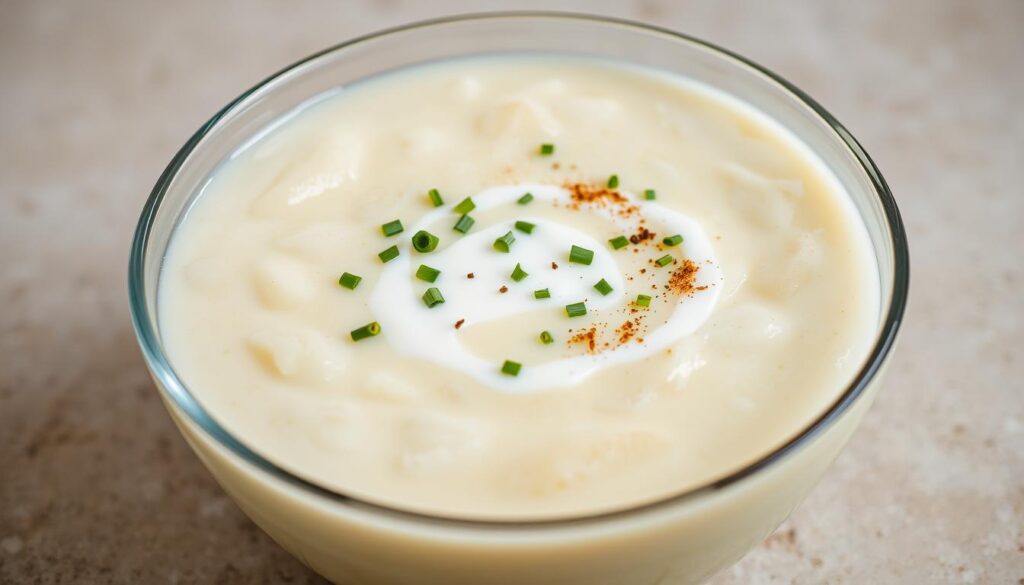
- Cool the soup completely before freezing to prevent the formation of ice crystals.
- Label the containers or bags with the date and contents.
- Store the soup in the freezer for up to 3 months.
Reheating Without Losing Creaminess
When reheating your creamy potato soup, do it gently. This prevents it from becoming too thick or separating. Reheat it over low heat, stirring occasionally, until it’s warm. If it’s thickened, thin it with broth or milk.
- Reheat the soup slowly to maintain its creamy texture.
- Avoid boiling the soup, as this can cause it to separate.
Nutritional Information and Dietary Adaptations
Enjoying a warm bowl of potato soup can be even better when you know its nutritional benefits. This dish not only warms your heart but also offers several health perks.
Calorie and Nutrient Breakdown
A serving of potato soup can have 150 to 400 calories. This depends on the potatoes, cream or milk, and any extra ingredients like bacon or cheese.
The soup’s nutrients include:
- Carbohydrates: Mainly from potatoes, giving the soup energy.
- Protein: Can be boosted with chicken, beans, or dairy.
- Fats: Mostly from cream, butter, or cheese, which can be adjusted.
Making Your Potato Soup Dairy-Free
If you can’t have dairy, you can still enjoy potato soup. Just swap dairy for non-dairy options.
Try these swaps:
- Use almond milk, soy milk, or coconut milk instead of regular milk or cream.
- Replace butter with vegan butter or olive oil.
Tips for Reducing Calories
To cut calories in your potato soup, try these tips:
- Use less cream and more broth or non-dairy milk to lower fat.
- Choose low-fat dairy or dairy alternatives.
- Add more potatoes, carrots, or celery for fiber and nutrients without extra calories.
With these tweaks, you can enjoy a healthier potato soup. It stays comforting and tasty.
Troubleshooting Common Potato Soup Problems
When making homemade potato soup, you might face a few common issues. These can be fixed with some simple tips. Whether it’s a watery soup, undercooked potatoes, or too much seasoning, we have solutions to help you get it right.
Fixing a Watery Soup
A watery potato soup can be a letdown. But, there are ways to thicken it. You can add more boiled potatoes or instant potato flakes to soak up the extra liquid. Or, blend some of the soup to make it creamier, then mix it back in.
Remedying Undercooked Potatoes
If your potatoes are not cooked enough, just keep simmering until they’re tender. Make sure to check them often to avoid overcooking.
“The key to a great potato soup is in the texture of the potatoes. They should be tender but not mushy.”
Salvaging an Overseasoned Soup
If your potato soup is too salty, you can fix it. Try adding a bit more broth or cream to dilute it. Or, adding sour cream or yogurt can balance the flavors.
| Issue | Solution |
|---|---|
| Watery Soup | Add boiled potatoes or instant potato flakes |
| Undercooked Potatoes | Simmer until tender |
| Overseasoned Soup | Dilute with broth or add dairy |
Conclusion: Enjoying Your Perfect Bowl of Potato Soup
Now you know how to make a delicious potato soup. It’s time to enjoy the warm, comforting bowl. It’s perfect for a chilly evening or a cozy night in.
The secret to great potato soup is in the details. Choose the right potato and balance flavors and textures. By following these tips and trying different ingredients, you can make a potato soup that’s just right for you.
Looking for a comforting meal or a healthy option? This versatile dish is perfect. So grab a spoon and enjoy the rich, creamy goodness of your homemade potato soup.

